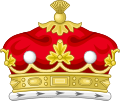| | | | | | | | Ralph Botevile [6] |
|
| | | | | | | | | | | | | | | | |
| | | | |
| | | | | | | | Thomas Thynne [6] | | William Thynne [6] [7]
d. 1546 |
|
| | | | | | | | | | | | | | | | |
|
| | | | | | | | John Thynne of Longleat [8]
c. 1515–1580 | | Francis Thynne [7]
c. 1544–1608 |
|
| | | | | | | | | | | | |
| | | | | |
| | | | John Thynneof Longleat [9]
1555–1604 | | Charles Thynne [10]
c. 1568–1652 |
|
| | | | | | | |
|
| | | | Thomas Thynne of Longleat [11]
c. 1578–1639 |
|
| | | | | | | | | | | | | |
| | | | | | | | | | |
| | | | | | | | | | Baronet of Caus Castle, of Kempsford in the County of Gloucester, 1641 |
|
James of Longleat [12]
1605–1670 | | Thomas of Richmond [13]
d. 1669 | | Henry Frederick Thynne
1615–1680
1st Baronet of Kempsford |
|
| | | | | | | | | | | | | | | | | | | | | |
| | | | | | | | | |
| | | | | | | | | Baron Thynne, 1680
Viscount Weymouth, 1682 | | | | | | | | | | |
|
| | | | Thomas of Longleat, [14]
1648–1682 | | Thomas Thynne [15]
1640–1714
inherited Longleat, 1682
1st Viscount Weymouth and Baron Thynne,
2nd Baronet of Kempsford | | James Thynne of Buckland
d. 1709 | | Henry Thynne Frederick
d. 1705 |
|
| | | | | | | | | | | | | unmarried | | | | | |
|
| | | | | | | | Henry Thynne [16]
1675–1708 | | | | | | Thomas Thynne d. 1710 |
|
| | | | | | | | two daughters but no sons | | | | | | | | | |
|
| | | | | | | | | | | | | | | | Thomas Thynne [17]
1710–1751
2nd Viscount Weymouth and Baron Thynne,
3rd Baronet of Kempsford |
|
| | | | | | | | | | | | | | | | | | | | |
| | | | | |
| | | | | | | | | | | | Marquess of Bath, 1789 | | Baron Carteret (2nd creation), 1784 |
|
| | | | | | | | | | | | Thomas Thynne [18]
1734–1796
1st Marquess of Bath,
3rd Viscount Weymouth and Baron Thynne,
4th Baronet of Kempsford | | Henry Carteret [19]
1735–1826
1st Baron Carteret |
|
| | | | | | | | | | | | | | | | | | | | | |
| | | | | | | | | | |
| | | | | | | | Thomas Thynne [20]
1765–1837
2nd Marquess of Bath,
4th Viscount Weymouth and Baron Thynne,
5th Baronet of Kempsford | | George Thynne
1770–1838
2nd Baron Carteret | | John Thynne
1772–1849
3rd Baron Carteret |
|
| | | | | | | | | | | | | | | | | Baron Carteret extinct, 1849 |
|
| | | | | | | | | | | | | | | | | |
| | | | | | | | | | |
| | | | Henry Thynne
[21]
1797–1837
3rd Marquess of Bath,
5th Viscount Weymouth and Baron Thynne,
6th Baronet of Kempsford | | Edward Thynne
1807–1884 | | Lady Charlotte Anne Thynne
1811–1895
marr.: Walter Montagu Douglas Scott, Duke of Buccleuch and had issue. |
|
| | | | | | | | | | | | |
| | | | |
| | | | John Thynne [22]
1831–1896
4th Marquess of Bath,
6th Viscount Weymouth and Baron Thynne,
7th Baronet of Kempsford | | Henry Thynne
1832–1904 |
|
| | | | | | | | | | | | |
|
| | | | Thomas Thynne
1862–1946
5th Marquess of Bath,
7th Viscount Weymouth and Baron Thynne,
8th Baronet of Kempsford | | Ulric Oliver Thynne
1871–1957 |
|
| | | | | | | |
|
| | | | Henry Thynne
1905–1992
6th Marquess of Bath,
8th Viscount Weymouth and Baron Thynne,
9th Baronet of Kempsford |
|
| | | | | | | | | | | | | | | | | |
| | | | | | | | | | | | | | | |
Thomas Timothy Thynne
1929–1930 | | Alexander George Thynn
1930–2020
7th Marquess of Bath,
9th Viscount Weymouth and Baron Thynne,
10th Baronet of Kempsford | | Christopher John Thynne
1934–2017 | | Valentine Charles Thynne
1937–1979 |
|
| | | | | | | | | | | | | | | | |
|
| | | | Ceawlin Thynn
b. 1974
8th Marquess of Bath,
10th Viscount Weymouth and Baron Thynne,
11th Baronet of Kempsford | | | | | | Lucien Henry Valentine Thynne
b. 1965 |
|
| | | | | | | |
|
| | | | John Alexander Ladi Thynn
b. 2014
styled Viscount Weymouth |
|





